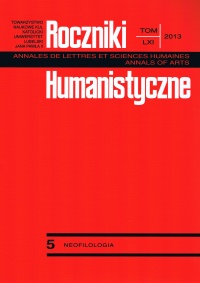From Metareference to Storytelling: Multimodality in Contemporary American Fiction
Abstract
The aim of this paper is to discuss the use of multimodality, that is simultaneous employment of verbal and non-verbal semiotic resources, in American fiction from the postmodern novel of the 1960s to the recent examples of novels that depart from the conventional, purely verbal format. In William H. Gass’s Willie Masters’ Lonesome Wife, the first text to be discussed, multimodality ties in with obsessive self-reflexivity, typical of high postmodernism, and mobilisation of the metaphoric potential of the printed codex as object: the metaphoric equivalence between the book and the body of the eponymous heroine constitutes the core of Gass’s exploration of the text-reader interaction. Like Willie Masters’ Lonesome Wife, VAS: An Opera in Flatland by Steve Tomasula relies on the semiotic potential of the book-body equivalence and contains explicitly metareferential elements; however, it goes beyond mere self-reflexive exploration of the status of a literary text: for Tomasula VAS as book and as novel becomes an embodiment of a transition from the human to the post-human condition. Finally, in Jonathan Safran Foer’s Extremely Loud and Incredibly Close, the last book to be discussed in this paper, multimodality is primarily employed as a storytelling device, which only indirectly—that is, via a juxtaposition of words and images—gives the novel a metareferential dimension.
References
Foer, Jonathan Safran. Extremely Loud & Incredibly Close. Boston and New York: Mariner Books, 2005.
Gass, William H. Willie Masters’ Lonesome Wife. TriQuarterly Supplement Number Two. Evanston: The Northwestern University Press, 1968.
Gibbons, Alison. Multimodality, Cognition, and Experimental Literature. New York and London: Routledge, 2012.
Hallet, Wolfgang. “The Multimodal Novel: The Integration of Modes and Media in Novelistic Discourse.” Narratology in the Age of Cross-Disciplinary Narrative Research. Ed. Sandra Heinen and Roy Sommer. Narratologia 20. Berlin and New York: Walter de Gruyter, 2009. 129-153.
Kaufmann, Michael. “The Textual Body: William Gass’s Willie Master’s [sic] Lonesome Wife.” Critique: Studies in Contemporary Fiction 35.1 (1993): 27-42
McCaffery, Larry. The Metafictional Muse: The Works of Robert Coover, Donald Barthelme, and William H. Cass. University of Pittsburgh Press, 1982.
McHale, Brian. Postmodernist Fiction. London and New York: Methuen, 1987.
Pier, John. “Intermedial Metareference: Index and Icon in William Gass’s Willie Masters’ Lonesome Wife.” The Metareferential Turn in Contemporary Arts and Media: Forms, Functions, Attempts at Explanation. Ed. Werner Wolf. Amsterdam and New York: Rodopi, 2011. 97-124.
Saal, Ilka. “Regarding the Pain of Self and Other: Trauma Transfer and Narrative Framing in Jonathan Safran Foer’s Extremely Loud & Incredibly Close.” Modern Fiction Studies 57.3 (2011): 453-476.
Samuels, Rolf. “Willie Masters’ Lonesome Wife as Pornographic Critique.” Richard Henry with Rolf Samuels and Karen Schiff, ed. Willie Masters’ Lonesome Wife by William H. Gass. A Casebook. Champaign, London, Dublin: Dalkey Press, n.d. <http://www.dalkeyarchive.com/book/?GCOI=15647100601620> N. pag. (11 April 2011)
Tomasula, Steve. VAS: An Opera in Flatland. Art and design by Stephen Farrell. Chicago: The University of Chicago Press, 2004. The first edition published in 2002.
Uytterschout, Sien, and Kristiaan Versluys. “Melancholy and Mourning in Jonathan Safran Foer’s Extremely Loud and Incredibly Close.” Orbis Litterarum 63.3 (2008): 216-236.
Copyright (c) 2013 Roczniki Humanistyczne

This work is licensed under a Creative Commons Attribution-NonCommercial-NoDerivatives 4.0 International License.





